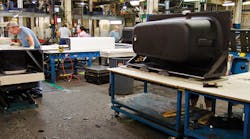SALEM, OHIO — Once a manufacturing mecca in the 1920s and ‘30s, the small eastern Ohio town located in the Rust Belt region of America is host to American Standard’s Americast plant.
As members of the trade press assembled at the American Standard facility in Salem, Gray Uhl, brand education director, Lixil Water Technology, explained that the plant has continued to produce Americast bathtubs for nearly 30 years — one Americast tub per minute, as a matter of fact — in addition to porcelain enamel on steel bathtubs, and acrylic tubs and whirlpools.
A long-time employer in eastern Ohio, the invention of Americast in the 1980s helped to revitalize this plant and local economy that had been depending on steel for so many years.
The factory has a long history in Salem, with the first metal manufacturing operation on the site beginning in 1872. Anyone who remembers all-metal kitchen cabinets has seen a product that came from a predecessor company, Mullins Mfg. Corp. There are old mechanical presses on the site that produced artillery shells during the war years. The plant today covers 500,000 sq. ft., employs 200 hourly workers and 25 salaried employees.
“The materials and the intellectual skill to work with them was already there in the area,” Uhl said.
Americast is an exclusive, patented material used in American Standard bathtubs, which features its patented process that fully bonds a high-quality porcelain surface with an enameling-grade steel and a molded reinforcement composite backing.
“American Standard reached out to the automotive and aerospace industries; the Americast composite material is similar to those used in those particular industries,” Uhl explained.
Although it weighs half as much as traditional cast iron, making it less costly to install, Americast’s three-layer construction offers durability, heat retention and sound-dampening qualities. Americast has its benefits over cast iron, Uhl said.
“Cast iron is difficult to ship and install and the warping and twisting that occurs in the firing process leads to dimensional instability,” he said. “In addition, cast iron sucks the heat out of the hot water in the tub.”
Mechanical and hydraulic presses stamp tub shapes out of low-carbon sheet steel in a series of operations. Tubs are formed in a series of stampings to shapes that can be classified as either “regular,” extended deck, extended apron, some combination of any or all of the three, and right- or left-hand drain. Lubricant used in the presses is washed off in a five-stage washer before the finishing process begins.
The steel tubs receive a primer that’s baked on at high temperature, then a finish coat that’s likewise baked on at more than 1,400° F. The topcoat contains titanium, which gives the finished tub its white appearance. The bottom of the tub then gets a slip-resistant coating called StanSure.
Americast was used in the first Princeton bathtubs, offering builders and homeowners a durable, lightweight alternative to cast iron with superior heat retention and noise reduction.
Pioneered following several years of research and development, the three-layer construction of Americast consists of a smooth porcelain-enamel finish on high-quality alloy backed by an injection-molded structural composite. The composite material helps protect the porcelain finish from surface chipping and crazing — lines/cracks in surface — caused by reverse impact damage. The Americast composition gives tubs a tight radius at the corners for maximum useable space in residential and hospitality bathroom settings.
The tubs are fed into the molding stations in batches because it’s advantageous to keep the molds operating for as long a period of time as practical. Each tub spends five minutes in the mold as the Americast composite material is injected at 2,200 psi. The line can produce 96 tubs per hour.
A pre-fabricated leveling grid underneath the tub provides extra support to the tub floor to prevent warping and cracking. This grid allows the tub to be easily slid into place or bedded in mortar, while also saving time when leveling.
“We recently improved the skid pattern and the reformatted design increases coverage by 40%,” Uhl said.
Offering added flexibility for builders, an optional above-the-floor rough installation leaves a few inches of clearance between the tub’s underside and the flooring so that pipe can be routed without breaking ground or relocating the drain.


